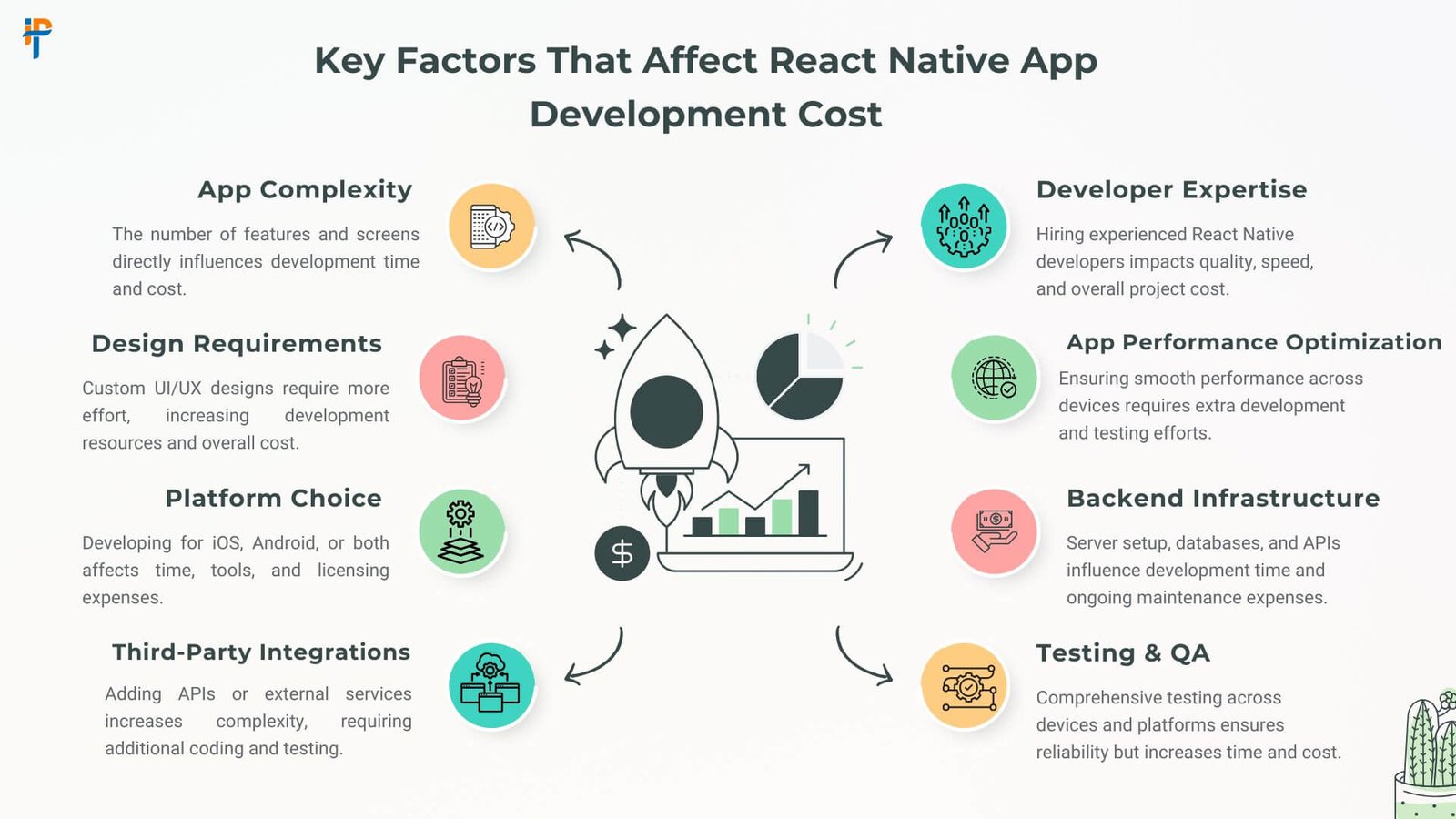Introduction: Why React Native is a Game Changer for Mobile Apps
Have you ever wondered why giants like Facebook, Instagram, and Airbnb chose React Native for their mobile applications? The answer lies in a perfect blend of cost-effectiveness, performance, and development speed that’s revolutionizing how businesses approach mobile app development. In today’s digital-first world, where every dollar counts and time-to-market can make or break your success, understanding React Native app development costs isn’t just helpful—it’s essential for making informed business decisions.
Think of React Native as the Swiss Army knife of mobile development frameworks. Just as this versatile tool eliminates the need to carry multiple instruments, React Native allows developers to write code once and deploy it across both iOS and Android platforms. This cross-platform capability has transformed the mobile development landscape, offering businesses a golden opportunity to reach wider audiences without breaking the bank. But here’s the million-dollar question: how much does it actually cost to develop a React Native app in 2024?
Understanding React Native App Development Cost
What is React Native?
React Native, Facebook’s brainchild launched in 2015, represents a paradigm shift in mobile application development. Unlike traditional native development that requires separate codebases for iOS and Android, React Native leverages JavaScript to create truly native mobile experiences. It’s like having a universal translator that speaks both iOS and Android fluently, allowing developers to craft applications that feel native to each platform while maintaining a single, manageable codebase.
The framework’s architecture bridges JavaScript code with native platform components, ensuring your app doesn’t just look native—it performs like one too. This innovative approach has attracted developers worldwide, with the React Native community growing exponentially year after year. The framework’s popularity stems from its ability to deliver near-native performance while significantly reducing development time and costs.
Average Cost Ranges for React Native Development
Let’s cut to the chase—what numbers are we talking about? React Native app development costs typically range from $15,000 to $300,000+, depending on various factors we’ll explore in detail. Here’s a breakdown of typical cost ranges based on app complexity:
React Native App Development Cost by Complexity
| App Complexity | Features | Development Time | Cost Range |
|---|---|---|---|
| Simple App | Basic UI, 5-10 screens, no backend | 2-3 months | $15,000 – $40,000 |
| Moderate App | Custom UI, 10-20 screens, API integration | 3-6 months | $40,000 – $120,000 |
| Complex App | Advanced features, 20+ screens, custom backend | 6-12+ months | $120,000 – $300,000+ |
| Enterprise App | Multiple integrations, high security, scalability | 9-18+ months | $250,000 – $500,000+ |
These figures represent market averages, but remember—your specific requirements will ultimately determine your investment. It’s like buying a car; a basic model gets you from point A to B, but if you need luxury features, advanced safety systems, or specialized performance, the price naturally increases.
Also Read- React Native Push Notifications for iOS: Firebase Setup Tutorial
Understanding React Native App Development Cost

App Complexity and Features
The complexity of your application serves as the primary cost driver in React Native development. Simple apps with basic functionalities like information display, simple forms, and standard navigation might cost significantly less than feature-rich applications incorporating real-time messaging, payment gateways, or augmented reality capabilities. Each additional feature adds layers of complexity, requiring more development hours, testing, and refinement.
Consider the difference between building a simple to-do list app versus creating the next Instagram. The to-do app might require basic CRUD operations (Create, Read, Update, Delete), while a social media platform demands user authentication, media uploading, real-time feeds, push notifications, and complex algorithms for content delivery. These advanced features don’t just add development time—they require specialized expertise, robust backend infrastructure, and extensive testing across different devices and scenarios.
Development Team Location and Expertise
Geography plays a crucial role in determining development costs, with hourly rates varying dramatically across regions. North American developers typically charge $100-250 per hour, while Eastern European developers might charge $40-80, and Asian developers often range from $20-50 per hour. However, don’t let price be your only compass—expertise, communication skills, and cultural alignment significantly impact project success.
The expertise level of your development team directly correlates with both cost and quality. Senior React Native developers command higher rates but often deliver cleaner code, better architecture, and fewer bugs—potentially saving money in the long run through reduced maintenance and faster development cycles. It’s the classic “pay now or pay later” scenario that every business must carefully evaluate.
Design Requirements and UI/UX Complexity
Visual appeal and user experience can make or break your application’s success. A well-designed app with intuitive navigation and delightful interactions commands user attention and drives engagement. However, sophisticated designs with custom animations, unique layouts, and platform-specific adaptations require additional investment in both design and development phases.
Custom Animations and Interactions
Creating smooth, engaging animations in React Native requires expertise and time. While the framework provides excellent animation APIs, implementing complex gesture-based interactions or physics-based animations demands specialized knowledge. These microinteractions—like the satisfying pull-to-refresh animation or smooth page transitions—might seem minor but significantly impact user perception and app quality. Each custom animation adds development hours, testing requirements, and potential performance optimization needs.
Also Read- AI App Development Cost in 2025: From MVPs to Full-Scale Solutions
Hidden Costs: Maintenance, Updates, and Third-Party Integrations
Ongoing Maintenance Expenses
Here’s what many businesses overlook: your app’s journey doesn’t end at launch—it begins. Maintenance costs typically range from 15-20% of the initial development cost annually. This covers bug fixes, security updates, OS compatibility updates, and performance optimizations. React Native’s frequent updates, while bringing improvements, sometimes require code refactoring to maintain compatibility.
Think of app maintenance like car servicing—skip it, and you’ll face bigger problems down the road. Regular updates keep your app secure, performant, and compatible with the latest devices. Factor in these ongoing costs from day one to avoid budget surprises later.
Third-Party Service Integration Costs
Modern apps rarely exist in isolation—they integrate with payment processors, analytics platforms, cloud storage services, and various APIs. While React Native’s vast ecosystem offers numerous pre-built integrations, each service typically involves setup costs, monthly fees, and potential customization expenses. Popular integrations like Stripe for payments, Firebase for backend services, or Twilio for communications add both functionality and recurring costs to your project.
Platform-Specific Costs: iOS vs Android vs Cross-Platform
iOS Development Considerations
While React Native promises “write once, run anywhere,” iOS development still requires platform-specific considerations. Apple’s strict App Store guidelines might necessitate additional development to meet requirements. You’ll need a Mac for building and testing, an Apple Developer account ($99/year), and potentially iOS-specific features like Apple Pay or HealthKit integration. iOS users typically expect polished, high-performance apps, which might require extra optimization efforts.
Android Development Considerations
Android’s fragmented ecosystem presents unique challenges. With thousands of device configurations, screen sizes, and OS versions, testing becomes more complex and time-consuming. While React Native handles much of this complexity, ensuring consistent performance across low-end and high-end devices might require additional optimization. The Google Play Developer account ($25 one-time fee) is more affordable than Apple’s, but the testing burden often offsets this initial savings.
Platform-Specific Development Considerations
| Aspect | iOS | Android | Cross-Platform (React Native) |
|---|---|---|---|
| Developer Account | $99/year | $25 one-time | Both required for full deployment |
| Testing Devices | Fewer variations | Many variations | Must test on both platforms |
| App Store Approval | Strict, 1-7 days | Lenient, 2-3 hours | Must satisfy both stores |
| Development Tools | Xcode (Mac required) | Android Studio (any OS) | Both needed for native modules |
| Market Share (US) | ~58% | ~41% | Access to ~99% combined |
Cost vs ROI: How React Native Saves Time and Money
Code Reusability Benefits
The crown jewel of React Native development is code reusability, typically achieving 70-90% code sharing between platforms. This isn’t just about writing less code—it’s about maintaining one codebase, fixing bugs once, and implementing features simultaneously across platforms. Imagine cutting your development time nearly in half while maintaining native performance. That’s the React Native advantage in action.
This reusability extends beyond initial development. Updates, bug fixes, and new features roll out faster when you’re managing a single codebase. Your development team becomes more efficient, knowledge transfer improves, and the overall development lifecycle accelerates. It’s like having a master key that opens multiple doors instead of juggling a heavy keychain.
Faster Time to Market
In today’s competitive landscape, speed matters. React Native’s hot reloading feature allows developers to see changes instantly without rebuilding the entire app, dramatically accelerating the development process. Combined with code reusability, this means your app can hit the market 30-40% faster than traditional native development approaches.
Faster deployment means earlier user feedback, quicker iteration cycles, and the ability to capitalize on market opportunities before competitors. This speed advantage often translates to significant competitive advantages and early revenue generation that can offset development costs.
When to Choose React Native Over Other Frameworks
Ideal Use Cases for React Native
React Native shines brightest when building content-driven applications, social media platforms, e-commerce solutions, and business applications that prioritize time-to-market and cross-platform presence. If your app relies heavily on device APIs, requires consistent UI across platforms, and doesn’t demand intensive computational processing, React Native offers an optimal balance of performance and development efficiency.
Startups and businesses seeking to validate ideas quickly find React Native particularly attractive. The framework’s flexibility allows for rapid prototyping and MVP development, enabling businesses to test market viability without massive upfront investments. It’s perfect for applications where native performance is important but not absolutely critical for every single interaction.
When to Consider Alternatives
However, React Native isn’t always the answer. Graphics-intensive games, apps requiring complex animations at 60fps consistently, or applications heavily dependent on platform-specific features might benefit from native development. If your app needs to squeeze every ounce of performance from the device or requires extensive use of new platform features immediately upon release, native development might justify the additional cost.
Consider native development for apps like high-performance games, augmented reality applications with complex 3D rendering, or system-level utilities. Flutter might be worth exploring for apps requiring highly customized UI with consistent pixel-perfect rendering across platforms. The key is matching the framework to your specific requirements rather than forcing a square peg into a round hole.
Also Read- How Much Does It Cost to Hire an App Developer in Dubai 2025
Tips to Optimize Your React Native Development Budget
MVP Development Strategy
Smart businesses start with a Minimum Viable Product (MVP) to validate concepts before committing to full-scale development. This approach typically reduces initial costs by 60-70% while providing valuable user feedback for future iterations. Focus on core features that deliver primary value, then expand based on user response and market validation.
An MVP doesn’t mean compromising on quality—it means being strategic about feature prioritization. Launch with essential features polished to perfection rather than numerous half-baked functionalities. This approach not only saves money but also accelerates learning and reduces the risk of building features users don’t actually want.
Outsourcing vs In-House Development
The eternal debate: build an in-house team or outsource? In-house development offers better control, easier communication, and long-term knowledge retention but comes with higher costs, including salaries, benefits, and infrastructure. Outsourcing can reduce costs by 30-60%, provide access to specialized expertise, and offer flexibility in scaling resources.
Consider a hybrid approach—maintain a small in-house team for core functionality and ongoing maintenance while outsourcing specific modules or temporary capacity needs. This strategy balances cost optimization with quality control and knowledge retention. Many successful companies use this model, keeping product ownership in-house while leveraging external expertise for specialized requirements.
Case Studies: Cost Breakdown of Successful React Native Apps

Let’s examine real-world examples to understand how established companies approached React Native development. Instagram integrated React Native into their existing native app, starting with simple views like the Push Notification settings. This incremental approach allowed them to test the waters without risking their entire application, ultimately achieving 85-99% code sharing for implemented features.
Walmart rebuilt their mobile app using React Native, achieving impressive performance improvements while reducing development time. Their investment, while substantial for a Fortune 500 company, delivered ROI through improved customer experience, faster feature deployment, and unified development teams. The key takeaway? Even large enterprises find value in React Native’s efficiency gains despite having resources for separate native teams.
Bloomberg’s consumer mobile app, built with React Native, launched in just 5 months—significantly faster than traditional approaches. Their development team reported high satisfaction with the framework’s capabilities and development speed. The app handles complex financial data, real-time updates, and interactive charts, proving React Native’s capability for sophisticated business applications.
Conclusion: Making Smart Choices for Your Mobile App Project
Navigating React Native app development costs requires balancing multiple factors—features, quality, timeline, and budget constraints. While the framework offers compelling advantages through code reusability, faster development, and cross-platform deployment, success depends on aligning these benefits with your specific business objectives and technical requirements.
Remember, the lowest bid rarely delivers the best value. Focus on finding the right balance between cost and quality, considering long-term maintenance, scalability, and user experience. React Native has proven its worth across industries and company sizes, from startups validating ideas to Fortune 500 companies optimizing development efficiency.
Your investment in React Native development isn’t just about building an app—it’s about creating a sustainable mobile presence that can evolve with your business. By understanding the cost factors, hidden expenses, and optimization strategies discussed in this guide, you’re equipped to make informed decisions that maximize ROI while delivering exceptional user experiences.
The mobile app landscape continues evolving, but React Native’s strong community, corporate backing from Meta, and proven track record suggest it will remain a viable, cost-effective solution for years to come. Whether you’re building your first app or modernizing existing solutions, React Native offers a compelling path forward in the mobile-first digital economy.
FAQ
How much does React Native app development cost?
How much does React Native app development cost per hour?
- North America: $100–$250/hour
- Eastern Europe: $40–$80/hour
- Asia (including India): $20–$50/hour
At IPH Technologies, we combine affordable rates with senior-level expertise, ensuring high-quality development without hidden costs.













.png)


